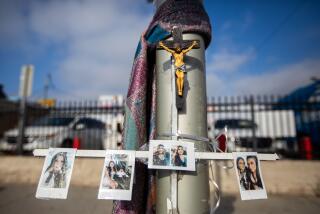Defendant walks out of his Guantanamo war crimes trial
- Share via
GUANTANAMO BAY, CUBA — An agitated Salim Ahmed Hamdan abruptly walked out of his war crimes trial Wednesday while the military jury watched a video in which the defendant was shown trussed, hooded and being badgered by armed and masked U.S. captors.
Hamdan returned after about an hour and watched the rest of the nearly two-hour black-and-white video filmed in a crude cell in an Afghan village. The only illumination was a flashlight into his face.
“I want to apologize for what I have done, for my behavior,” the former driver for Osama bin Laden told the judge, Navy Capt. Keith J. Allred, referring to his exit from the courtroom.
Hamdan suggested it was because of tension with his longest-serving lawyer, former Navy Lt. Cmdr. Charles Swift.
But it was obvious that he was uncomfortable watching the video of his first interrogation, in which U.S. soldiers in balaclavas accused him of lying about everything from his employment to his daughter’s name.
The developments in the Guantanamo courtroom provided a window onto the life of a captive in the chaotic aftermath of the October 2001 U.S.-led invasion of Afghanistan, when aerial bombardments targeted Al Qaeda strongholds.
Hamdan’s Nov. 24, 2001, capture at a roadblock in the southern Afghan village of Takhteh Pol has been portrayed by the Pentagon as an interception on the battlefield.
But the video, shown in two parts, made clear that it was local Afghan fighters who seized Hamdan as he returned from driving his family to safety across the border in Pakistan.
The six senior U.S. officers serving as jurors in the first war crimes trial here watched with rapt attention as an unseen interrogator asked Hamdan about two SA-7 surface-to-air missiles found in the car he said he had borrowed for the trip out of Kandahar.
Hamdan acknowledged that the missiles were in the Toyota but said they belonged to the friend who had lent him the vehicle, as did a weapons license and other documents found inside.
Asked why he fled the Afghans who had already had one deadly engagement at the roadblock that day, Hamdan replied: “I was scared. A person gets scared.”
When he was accused of lying about a postcard found in the car, which he told the interrogator had been written by his wife, Saboura, but signed “Fatima,” the name of his 21-month-old daughter, Hamdan lamented: “It’s all finished for me. Why should I lie?”
The video depicted Hamdan wincing in pain after being deposited on his knees on the floor of a windowless room. A spotlight was trained on his clavicle from behind the camera, and a masked U.S. soldier with an assault rifle stood behind him.
At least one other soldier stood outside the camera’s view, and an American voice in the background suggested a third presence. The interrogator spoke Arabic haltingly and with an English inflection.
Hamdan asked permission to move his legs, which were swaddled. His feet were chained and his hands bound with plastic “flexicuffs,” like notched garbage-bag ties. His hood was removed only for questioning.
He rubbed his ankles and moaned quietly after the restraints were removed.
Earlier in the day, the prosecution wrapped up testimony by its star witness, former FBI Al Qaeda expert Ali Soufan.
Soufan cast Hamdan as a trusted servant to Bin Laden but someone indifferent to the inner workings and ideology of the terrorist organization.
“Sometimes he used to get bored with these statements, hearing them again and again,” Soufan said of Hamdan’s reaction to Bin Laden’s speeches and appeals for Al Qaeda backers to offer themselves for suicide missions.
Under questioning by Justice Department attorney John Murphy, Soufan said that still images from two videos of Hamdan escorting and guarding Bin Laden showed that the Al Qaeda leader trusted his driver with his life.
Murphy was warned by Allred against leading his witness after asking Soufan whether the assignments Bin Laden gave Hamdan demonstrated that he held “the keys to the Al Qaeda terror operations.”
The prosecution had promised on the first day of the trial to show that Hamdan was one of the few in Bin Laden’s entourage to learn the intended fourth target of the Sept. 11 suicide hijackers.
But Soufan testified that Hamdan overheard a discussion by Al Qaeda leaders while driving them some time after the attacks. Hamdan told Soufan in an interrogation here in 2002 that he’d heard mention of “the dome” -- apparently meaning the U.S. Capitol -- but didn’t know to what it referred.
Soufan also gave detailed interpretations of pink code cards found in the vehicle Hamdan had driven. The three cards contained lists of numbers corresponding to words Al Qaeda members could use in radio communications to inform others while masking the message to eavesdroppers.
The numbers referred to actions (121 for bombing, for example), objects (112 for surface-to-air missiles) and people (1 for Taliban leader Mullah Mohammed Omar, 4 for Bin Laden and 10 for self-proclaimed Sept. 11 mastermind Khalid Shaikh Mohammed).
Defense lawyer Harry H. Schneider Jr. attempted to show that Hamdan had no more than a peripheral role in the operation by asking Soufan where the driver stood in the coded hierarchy.
Soufan responded that there was no reference to Hamdan in the cards.
--
More to Read
Sign up for Essential California
The most important California stories and recommendations in your inbox every morning.
You may occasionally receive promotional content from the Los Angeles Times.














